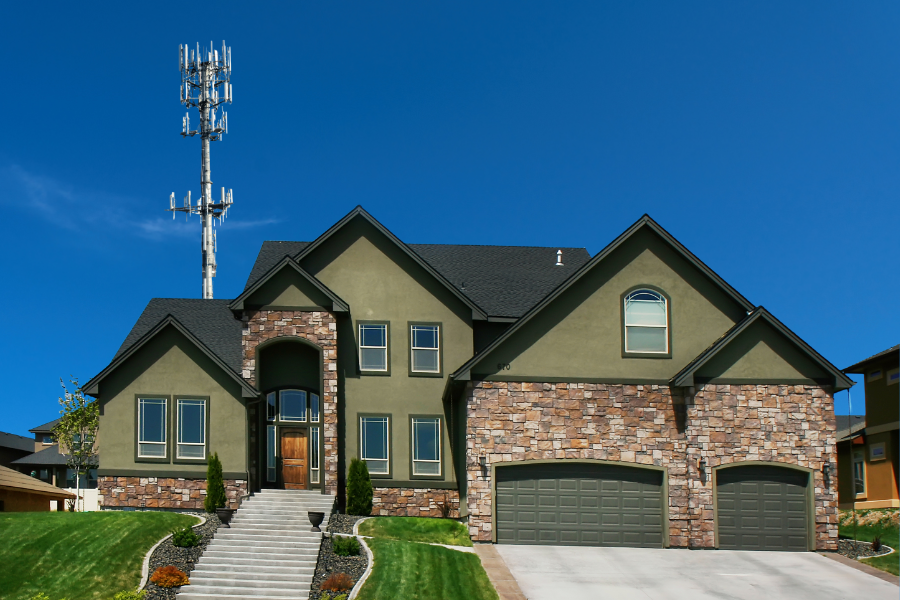
Realtor Evidence and Published Research on Market Impacts
Realtors and peer-reviewed studies report that cell towers can reduce home property values by up to 20 percent. Buyers avoid properties near towers, citing aesthetics and health concerns. Expert appraisers, municipal filings, and international research document lasting devaluation and loss of marketability from large cell tower structures placed close to residential neighborhoods.
This page compiles documentation of how cell towers can drop property value. Everything is hyperlinked to source. Environmental Health Sciences has a factsheet you can download at this link.
“In my opinion from extensive experience I will tell you the cell tower will negatively effect the price of the property between 15% -30%. Not only that but close to 90% of my clients would refuse to consider looking at or buying the property. The visual obstruction made by the Cell Tower would take away peace and tranquility that my clients move to the country to achieve.”
-Statement by Birmingham, MI licensed realtor
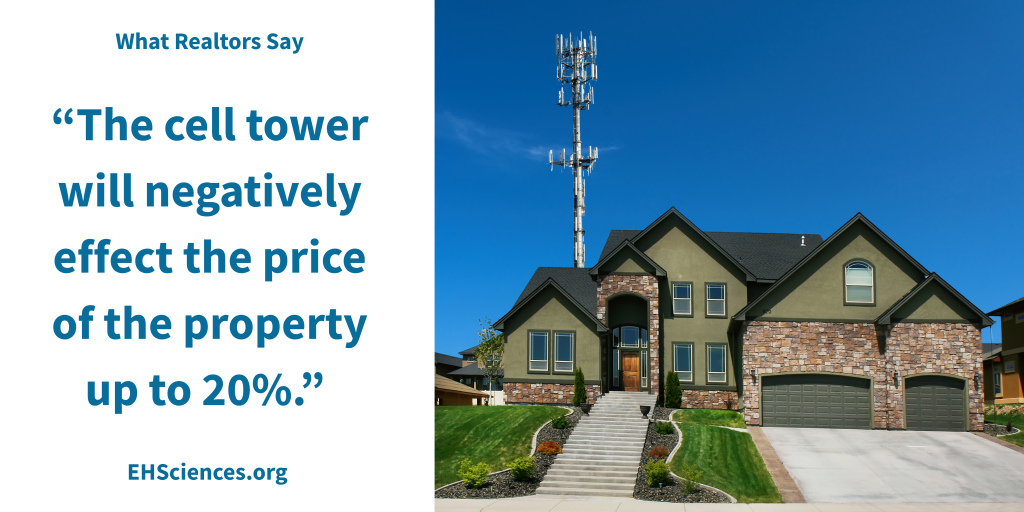
Would you buy a home near a cell tower?
- Realtors say visible towers can cut home values by up to 20%, with surveys showing 94% of buyers say they would pay less or avoid such properties.
- Regulatory filings to the FCC by counties and coalitions representing over 1,800 communities warn of cell towers’ significant negative impacts on aesthetics and property values.
- Peer-reviewed studies across the U.S., Australia, and South Africa find statistically significant price declines near towers.
“While the magnitude of the impact varies, the studies uniformly indicate that there is a significant impact on residential property values from installation of cell phone towers…”
-Report and Declaration by David E. Burgoyne, ASA, SR/WA Certified General Real Estate Appraiser Submitted for the Smart Cities Coalition of over 1800 governments.
Large cell towers are often effectively permanent structures, and their presence can lock in property devaluation for decades. Once they are up, the law allows them to go higher with little public process and they are very hard to move or take down.
What Realtors Say About Cell Towers Near Homes
“Buyers are extremely hesitant to purchase homes located near cell towers, and in many cases, homes next to towers take longer to sell and ultimately sell for less.”
“Prospective buyers always keep two main things in mind: location and aesthetics. No one prefers to live near a 195-foottall cell tower, as they are unsightly and always visible, and will choose another location if possible.”
“In my professional experience, a visible cell tower in close proximity to a property can reduce its value by as much as 20%.”
“As realtors working in this market, we consistently see that towers negatively impact demand, creating stigma that directly translates into lower property values.”
“Cellphone towers bring extra tax revenue and better reception to a section of the city, but many are skeptical because of the potential health risks and the impact on property values. Increasing numbers of people don’t want to live near cell towers. In some areas with new towers, property values have decreased by up to 20%.”
– National Business Post, “Your new neighbor, a cell tower, may impact the value of your home”
“An overwhelming 94 percent of home buyers and renters surveyed by the National Institute for Science, Law & Public Policy (NISLAPP) say they are less interested and would pay less for a property located near a cell tower or antenna.”
“Of the 1,000 survey respondents, 79% said that under no circumstances would they ever purchase or rent a property within a few blocks of a cell tower or antennas, and almost 90% said they were concerned about the increasing number of cell towers and antennas in their residential neighborhood.”
– REALTOR Magazine, “Cell Towers, Antennas Problematic for Buyers”
“Wireless companies are installing boxes in front of homes as part of their 5G network rollout. But homeowners aren’t pleased, calling the chest freezer–sized boxes a big eyesore in their front yards.”
“Wireless companies do not need to get permission from homeowners before installing the boxes. They don’t even need to notify them beforehand because the boxes are installed on a public right-of-way. This land is owned by the county, even if it does appear in a person’s front yard.”
Regulatory Filings by Cities and Municipalities
In 2017, a coalition of over 1,800 local governments known as the Smart Communities Siting Coalition sued to oppose the FCC’s decision to fast track the installation of small cell infrastructure, stripping local authorities of much of their decision-making power. In their extensive filings, the Coalition highlighted the detrimental impacts of cell towers and small cells on nearby property values.
“Smart Communities provided an expert analysis to highlight for the Commission the potential impacts of wireless facilities on adjoining property values. Burgoyne concludes many deployments of small cells could affect property values, with significant potential effects.”
“Considering that the Smart Communities’ prior filings show that the addition of facilities of this size diminish property values, it is strange for the Commission to assume that approval can be granted in the regulatory blink of an eye….”
“…allowing poles to go up in areas where poles have been taken down has significant impacts on aesthetics (not to mention property values).”
“There has been significant research regarding the question of the impact on residential property values from construction of cell phone towers in neighborhoods. The results of these studies vary but they commonly indicate that there is a significant impact. While the magnitude of the impact varies, the studies uniformly indicate that there is a significant impact on residential property values from installation of cell phone towers. Not surprisingly, the studies that show little or no impact are universally commissioned by and paid for by the telecommunications industry.”
Published Analysis on How Cell Towers Drop Property Values
“Property transaction data collected from two suburbs within the Brisbane City Council were analysed adopting the spatial hedonic property valuation model. The estimated models were statistically significant and were largely in line with theoretical expectations. The results revealed that proximity to cell phone towers negatively affects house values, decreasing as the distance from the tower increases. A suitable compensation programme for nearby property owners is, therefore, suggested as being an appropriate policy response.”
“Findings: The results show a significant impact that proximity of [cell phone tower base stations (CPTBS)] has on residential property sale prices. However, the impact of CTPBSs’ proximity on residential property prices depends on their distance from the residential properties. The closer a residential property is to the CTPBS, the greater the impact that the CTPBS will have on the selling price of the residential property.”
“For properties located within 0.72 kilometers of the closest tower, results reveal significant social welfare costs with values declining 2.46% on average, and up to 9.78% for homes within tower visibility range compared to homes outside tower visibility range; in aggregate, properties within the 0.72-kilometer band lose over $24 million dollars.”
“We take advantage of a rich dataset of residential housing sales from central Kentucky that contains an extensive set of structural housing characteristics and precise location information. This allows us to overcome endogeneity issues caused by unobservable characteristics correlated with antenna location. The best estimate of the impact is that a property with a visible antenna located 1,000 feet away sells for 1.82% ($3,342) less than a similar property located 4,500 feet away. The aggregate impact is $10.0 million for properties located within 1,000 feet. (JEL Q51, R21)”
“The research on the possible effect of cell towers on property values is extensive. In general, proximity to a cell tower appears to have a negative effect on property values. A study from the University of South Alabama analyzed over 23,000 home sales in Mobile County, Alabama relative to their proximity to cell towers. The researchers found that homes within 0.72 km of a cell tower decreased in value by an average of 2.65%. In addition, if the cell tower was visible from the property, then the properties decreased an average of 9.78%. A similar study in Kentucky found that properties within 1,000 feet of a cell tower sold for 1.82% less than a similar property located 4,500 feet away.”
The Department of Housing and Urban Development (HUD) Treats Towers as “Hazards and Nuisances”
The U.S. Department of Housing and Urban Development (HUD) Handbooks require appraisers to flag safety and marketability risks related to nearby towers or power lines. If a home lies within an easement or is too close to a cell tower or power line (both of which emit non-ionizing radiation), the appraiser must report it as a potential deficiency, comment on how it affects the property’s marketability, and determine whether encroachment rules apply.
Cell Towers as “Hazards and Nuisances” for Realtors
The California Association of Realtors’ Property Sellers Questionnaire has a section where sellers must note “neighborhood noise, nuisance or other problems from.. ” and includes cell towers and high voltage transmission lines on the long list problems.
The US Department of Housing and Urban Development (HUD) has long treated cell towers as “Hazards and Nuisances.”
“With regard to new FHA originations, the guide provides that “the appraiser must indicate whether the dwelling or related property improvements are located within the easement serving a high-voltage transmission line, radio/TV transmission tower, cell phone tower, microwave relay dish or tower, or satellite dish,” which is radio, TV cable, etc. “If the dwelling or related property improvement is located within such an easement, the DE Underwriter must obtain a letter from the owner or operator of the tower indicating that the dwelling and its related property improvements are not located within the tower’s engineered fall distance in order to waive this requirement.”
The HUD Handbook 4000.1 states:
“The Appraiser must notify the Mortgagee of the deficiency of MPR or MPS if the dwelling or related property improvements are located within an Easement or if they appear to be located within an unsafe distance of any power line or tower.
The Appraiser must note and comment on the effect on marketability resulting from the proximity to such site hazards and nuisances. The Appraiser must also determine if the guidelines for Encroachments apply.”
Factsheet on Cell Towers and Property Values
Download EHS Factsheet on Property Values and Cell Towers
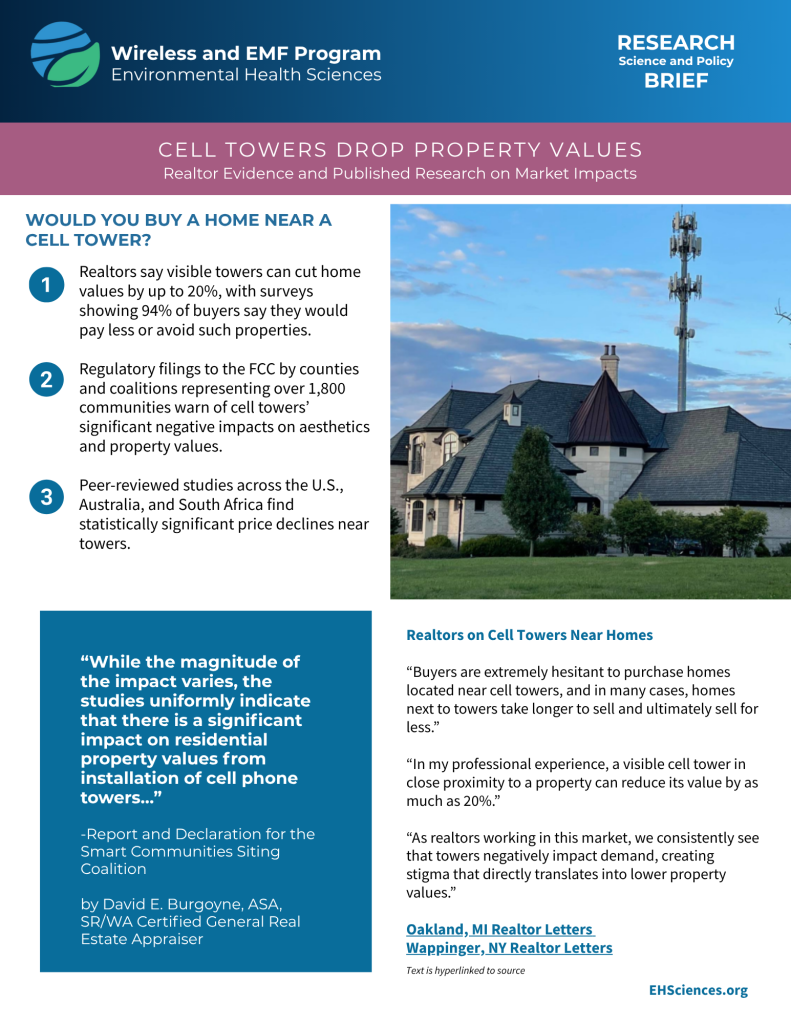
Science on Cell Tower Health Effects
Families Do Not Want a Cell Tower Nearby Because of the Increasing Science on Health Impacts From Cell Towers
73.6% of global studies on people living near cell towers found harmful effects, according to a research Review by Balmori published in Environmental Research (2022). A large scale animal study published in Environmental Research by Falcioni et al. (2018) found elevated cancer rates in rats exposed to radiofrequency (RF) radiation at levels permitted for cell tower emissions. The European Parliament commissioned report titled “Health Impact of 5G”, concluded that widely used RF radiation frequencies (450–6000 MHz) are likely carcinogenic to humans and may harm male fertility and early developmental stages such as embryos and newborns.
Study Highlight: Cell Tower Radiation Study Finds Cell Tower Exposures Can Be Higher Than Cell Phone Use For Children
While industry representatives often claim that radiation from cell towers is too “low” to cause adverse health effects, research shows that the cumulative exposure from nearby cell towers can exceed the RF radiation exposure children receive from typical cell phone use. A 2023 study published in Environmental Research by Lee and Choi found that continuous 24-hour downlink signals from cell towers produced more than a ten-fold higher cumulative daily energy absorption in the brain compared to a child’s exposure from mobile phone use.
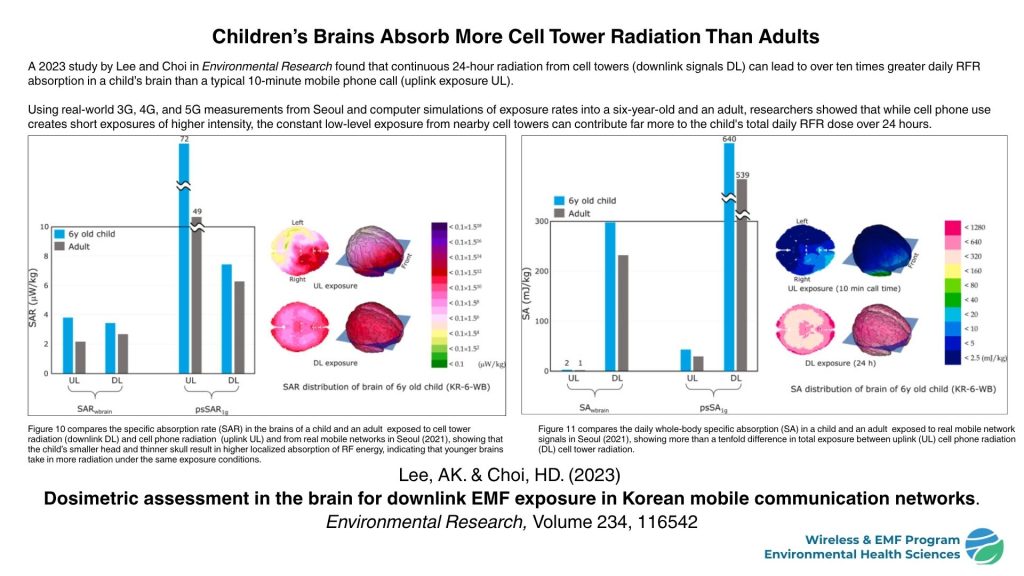
Numerous Research Publications Recommend a 1,500 foot Setback for Cell Towers
- Pearce (2024) states “that deployment of base stations should be kept as efficient as possible to minimize exposure of the public to RFR and should not be located less than 500m from the population.”
- Rodrigues et al. (2021) concludes that to “avoid hazards to human health, the safest solution would be to switch off the RBS (radiobase station) in an area within a 500 m radius from residences, workplaces, hospital areas, kindergartens, and buildings.”
- Dode et al. (2011) found higher deaths from tumors within 500 meters from cellular base stations.
- Levitt & Lai (2010) state, “as a general guideline, cell base stations should not be located less than 1500 ft (*500 m) from the population, and at a height of about 150 ft (*50 m).”
- Khurana et al. (2010) found that eight of the 10 studies reported increased prevalence of adverse neurobehavioral symptoms or cancer in populations living at distances less than 500 m from base stations.
The U.S. Permits High RF Radiation Exposures Compared to Other Countries
The U.S. is among the countries that allow for the highest levels of cell tower RF radiation in the environment.
The graph below shows the selected countries’ regulations regarding public exposure limits for 1800 W/m2 equivalent plane wave density RF radiation, applicable to schools and/or homes. Many countries have limits that apply to places of “sensitive use” such as apartment buildings, schools, hospitals, permanent workplaces, and children’s playgrounds. The U.S. has no specific safeguards for children or schools.
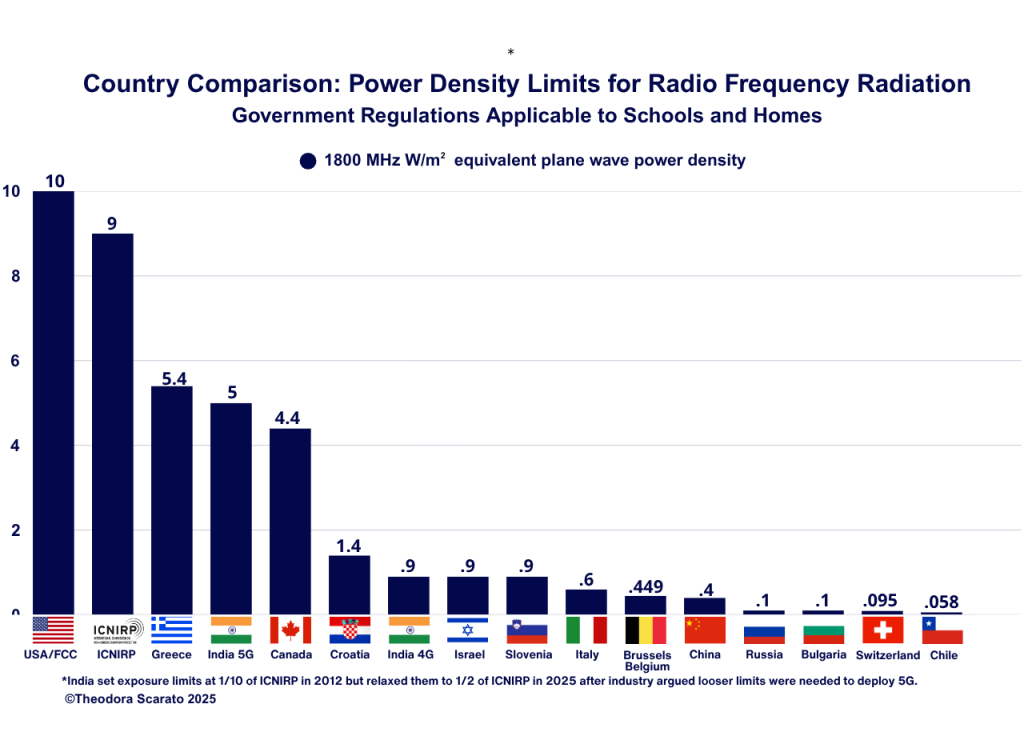
U.S. School Districts that Ban New Cell Towers
- Los Angeles CA
- Palo Alto CA
- Temecula Valley CA
- West Linn-Wilsonville OR
- Portland OR, Loudoun County VA.
U.S. Communities with Cell Tower Setback Policies Establishing Minimum Distance Requirements Between Wireless Antennas and Homes, Schools, or Other Sensitive Areas
- Shelburne MA (3,000 ft away from schools, 1,500 ft away from homes)
- Williamson County TN (1,500 ft schools)
- Copake NY (1,500 ft homes/schools)
- Sallisaw OK (1,500 ft homes)
- Walnut Creek CA (1,500 ft schools)
- Calabasas CA (1,000 ft homes/schools)
- Scarsdale NY (500 ft homes/schools)
- San Diego County CA (300 ft schools)
- Bedford NH (750 ft residential)
- Bar Harbor ME (1500 ft schools)
